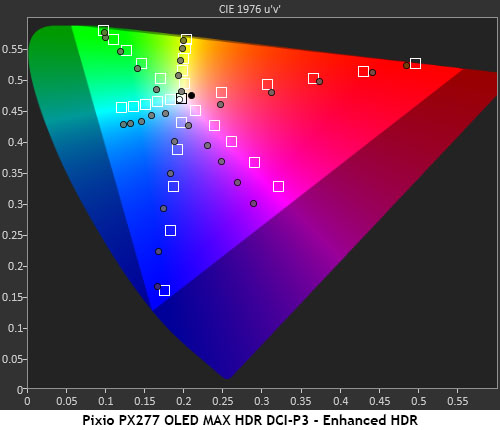Why you can trust Tom's Hardware
Our HDR benchmarking uses Portrait Displays’ Calman software. To learn about our HDR testing, see our breakdown of how we test PC monitors.
The PX277 OLED MAX responds to HDR10 signals with two additional picture modes, Auto and Enhanced. There are no other adjustments available.
HDR Brightness and Contrast



For this test, I measured a 25% window pattern and came up with an 814 nits peak. The PX277 OLED MAX is plenty bright. Pixio claims 1,000 nits for a 3% window, and I have no reason to doubt this. In terms of HDR brightness, black levels, and contrast, it is on par with the competition.
Grayscale, EOTF and Color



When I observed a grayscale step pattern in the PX277 OLED MAX’s HDR mode, I could see the blue errors plainly in the steps from 40 to 70%. This error cannot be fixed since the color temp controls are grayed out. I saw the same behavior in Auto and Enhanced modes. When I measured the EOTF, Auto looked quite dark, with most of the trace below the reference. Enhanced looked much better, but by the numbers, it is too bright, from 40% to the tone-map transition at 70%. The picture has a lot of punch but neither HDR mode conforms to standard.
The gamut charts look good with some hue errors, but most saturation points are close to their targets. With a linear progression, there will be no loss of detail. And the DCI-P3 gamut is fully covered. Rec.2020 tracks the same way until the PX277 OLED MAX runs out of color at just past 80% for red and around 70% for green. Blue gets up to 95%. This is typical performance, but the hue errors are a little greater than other HDR monitors I’ve tested. That’s due to the blue grayscale tracking.
Test Takeaway: The PX277 OLED MAX’s HDR color and grayscale are somewhat cool, making the image look bright but a little flat. Warm tones are understated. Its color palette is good for sports games, but natural scenes are less vibrant than they could be. There is plenty of light output with bright highlights and deep blacks. While its HDR image is excellent, it has room for improvement when compared to its direct competition.
MORE: Best Gaming Monitors
Get Tom's Hardware's best news and in-depth reviews, straight to your inbox.
MORE: How We Test PC Monitors
MORE: How to Buy a PC Monitor
MORE: How to Choose the Best HDR Monitor

Christian Eberle is a Contributing Editor for Tom's Hardware US. He's a veteran reviewer of A/V equipment, specializing in monitors. Christian began his obsession with tech when he built his first PC in 1991, a 286 running DOS 3.0 at a blazing 12MHz. In 2006, he undertook training from the Imaging Science Foundation in video calibration and testing and thus started a passion for precise imaging that persists to this day. He is also a professional musician with a degree from the New England Conservatory as a classical bassoonist which he used to good effect as a performer with the West Point Army Band from 1987 to 2013. He enjoys watching movies and listening to high-end audio in his custom-built home theater and can be seen riding trails near his home on a race-ready ICE VTX recumbent trike. Christian enjoys the endless summer in Florida where he lives with his wife and Chihuahua and plays with orchestras around the state.
